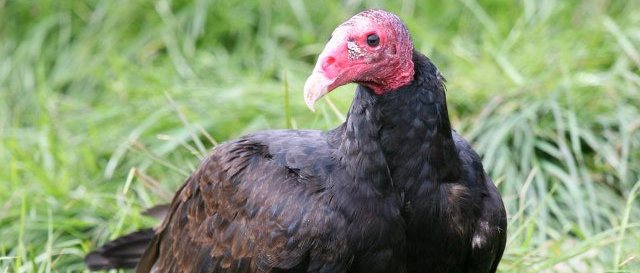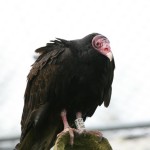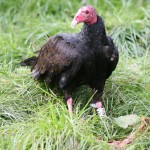Fact File
Characteristics
- The word vulture comes from the latin ‘vellere’, which
means to pluck or tear. Its scientific name, Cathartes aura,
means either “golden purifier” or “purifying breeze.” - Roost in large community groups, sometimes with several
hundred vultures together but will search for food
independently during day. - Have a very good sense of smell and are thought to be
one of the few birds who use smell extensively. The part
of the brain responsible for processing smells is large,
compared to other birds. Heightened ability to detect
odours - can detect just a few parts per trillion - allows
them to find dead animals below a forest canopy - Based on their wing-surface-to-weight ratio they have light
wing loading, meaning they can use thermals more
effectively and are more buoyant than other vultures. - Known for their defence mechanism of regurgitating
semi-digested meat,which deters most predators due to
its strong smell.
Turkey Vulture
Cathartes aura
Aves (birds) — Falconiformes (diurnal birds of prey) — Cathartidae (New World Vultures)
Turkey Vultures are new world vultures from the Americas. They were so named because their bald red heads and dark plumage resemble those of turkeys. Like many other vultures, they have bald heads as a hygienic adaptation to scavenging carrion. Bald heads are easier to keep clean and so reduce the chances of the bird becoming infected.
They use thermal air currents to fly, keeping themselves aloft with minimal effort. They have great vision and smell, and fly low enough that they can detect the gases that decaying carcasses give off.
Although turkey vultures are classified as “low concern”, they can be affected by over-fishing and agriculture encroachment, which reduce number of carcasses available to the birds, and also by lead poisoning from carcasses shot by buckshot or lead bullets.
Habitat: Occupy a diverse range of habitats, both forested as well as
open environments. Can literally be found anywhere they can
effectively find a food (carrion) supply.
Vital Statistics:
–Average weight: 2kg
–Average length: 1.72m
Life Expectancy:
In the wild up to: 16 years
In captivity up to: 30 years
Diet: Are scavengers and eat carrion.
Distribution: Can be found as far north as the southern border of Canada and as far south as Tierra del fuego, Chile.
Conservation: Our related conservation charity is the APCPP- Association for Protection of Condors and Penguins of Peru. This project is based in north west Peru, where our rangers patrol the beaches to reduce pollution and poaching. We also work on reforesting the landscape, and work in collaboration with scientific research projects in the area. This project also works with fishing companies to ensure they rotate their fishing areas, preventing over-fishing and increasing food sources. Finally, we also supplement vultures with food to increase survival rates.





